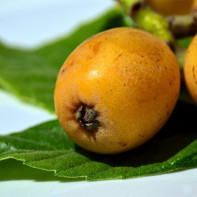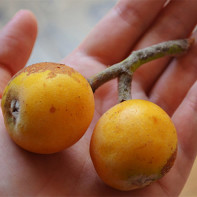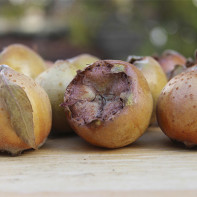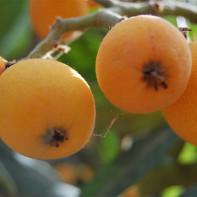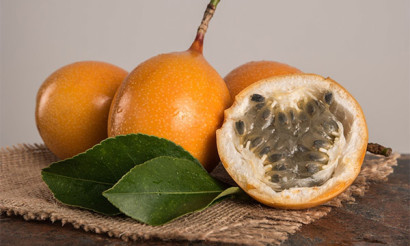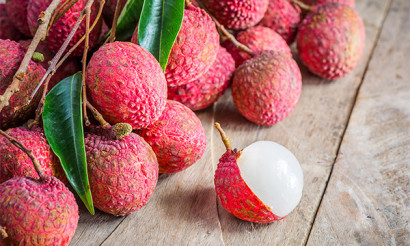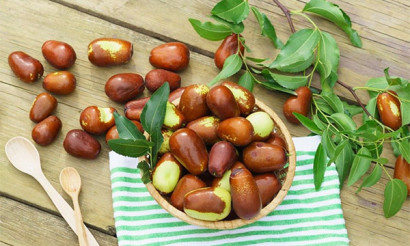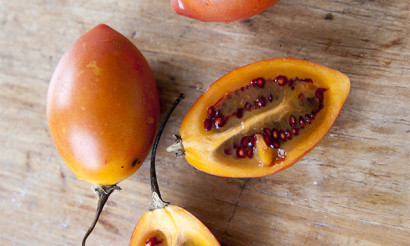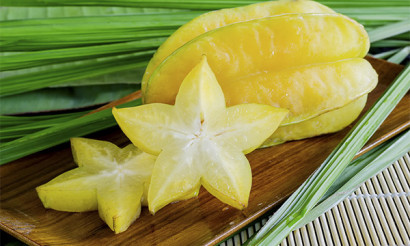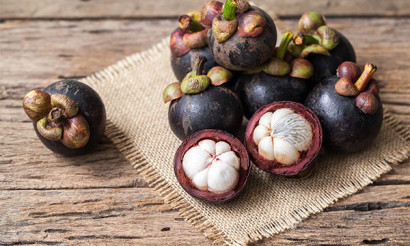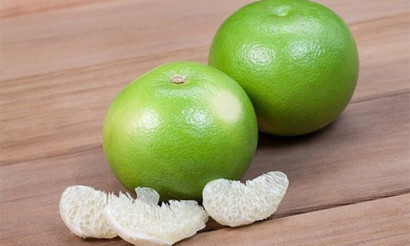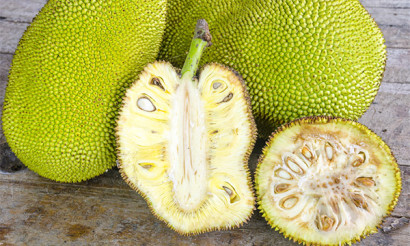Cherry plum: what is this fruit, useful properties and contraindications
When people hear the word "medlar", then, as a rule, in the head there are images of heroes of fairy tales and a variety of oriental sweets. In fact, the medlar is a plant that, until recently, was used as an ornamental crop, but today it has taken its place among edible fruits.
- What is the medlar and where does it grow
- Types
- What does the medlar taste like
- Composition and calories
- Useful properties of medlars
- General benefits
- For Women
- For Men
- During Pregnancy
- Breastfeeding
- For children
- When losing weight
- Health benefits of medlar nuts
- Medicine properties of medlar leaves
- Cosmetological Usage
- Cherry plum in cooking
- Medical use of medications
- Harm and contraindications
- How to choose and store medlar
- How to eat medlar fruit
- Can I eat the seed?
- What to cook with medlars: Recipes
- Jam
- Compote
- Can we give medlars to animals?
- Interesting facts about the medlar fruit
What is medlar and where does it grow?
The medlar is a plant in the Rosaceae family, subfamily Applewood. Other names for the crop are "ezgil" and siskin tree. The name "medlar" is borrowed from the Turkish language, into which it came from Greek.
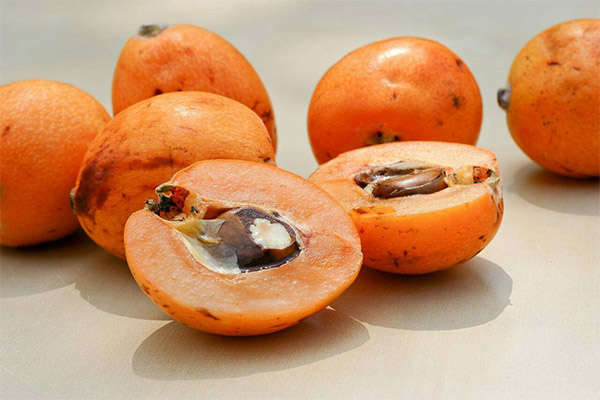
The evergreen tree has dark gray bark and dark green elliptical-shaped leaves. Under optimal growing conditions, the trees can grow up to 8 m tall, but they are usually no taller than 6 m. In autumn, the leaves turn red. The end of spring and beginning of summer is the season of active flowering of the medlar. The white five-petaled flowers emit a scent that attracts various insects, including those that pollinate the plant itself.
The brown-red fruits are 20-30 mm wide and spherical or pear-shaped. The ripe fruit is quite firm to the touch and has a sour taste. They should only be eaten after being stored for a long time. Over time, they decrease in size and gain a sweet taste and soft texture.
Gardeners prefer to cultivate German mushrooms. Despite the name, the culture did not originate in Germany, but in the territory of South-Eastern Europe and South-Western Asia. It was introduced to Germany by the Romans. South Ossetia, Armenia, Crimea, Azerbaijan, Georgia, North Caucasus and Ukraine - these are the places where the deciduous plants are found today.
It is known that people were engaged in the cultivation of medlar about 3 thousand years ago. Ancient Greeks were first interested in it, and later, in the Middle Ages, it was included in the list of especially important fruit plants. But after a while, when sailors began to bring to Europe exotic fruits from other continents, medlar has lost a significant portion of its former popularity. Today, it is rare to find sagebrush trees in gardens.
Varieties
There are more than 30 different varieties of medlar, but only 2 species are popular:
- Germanic (Caucasian). It grows in the Crimea, the Caucasus and the southern part of Europe. The flowering period begins in the second half of May, harvested in autumn, usually at the first frost. The flowers have red stamens and the 5-cm-long fruits are red-brownish in color. The taste of the fruit is similar to apple puree.
- Japanese. Occurs in China and Japan. The flowering period begins in October and harvesting begins in May. The fragrant flowers are cream-white in color. The fruits are yellow-orange in color and pear-shaped. The fruit does not exceed 10 cm in diameter.
What does the medlars taste like?
The medlar fruits have a peculiar taste. It is sour but has a similar taste to guava and passion fruit. Depending on maturity, the degree of sweetness also varies - ripe fruits are less sour and more sweet.
Composition and calories
100 g of the product contains:
- Calories - 47 kcal.
- Protein - 0,4 gr.
- Fats - 0,2 gr.
- Carbohydrates - 10.4 g.
Cherry plum has many medicinal properties necessary for the human body. The fruit contains vitamins such as A, C, PP. In addition, the product is rich in iron, zinc, copper, selenium, phosphorus, potassium, sodium, magnesium and calcium, as well as folic acid, monounsaturated fats - omega-3 and omega-6 fatty acids. The fruit is low in cholesterol and calories and contains almost no lipids or proteins.
Useful properties of medlars
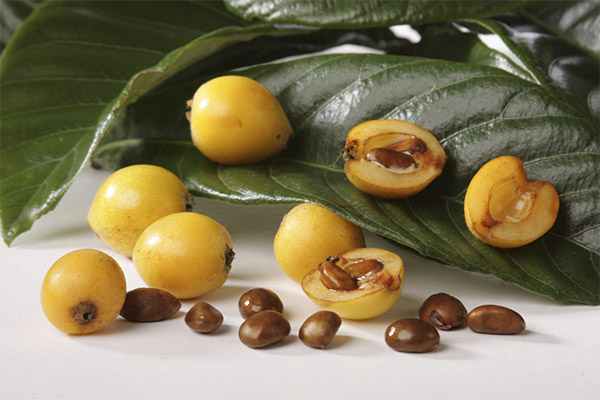
General benefits.
- Strengthens the immune system. Vitamin C contained in medlars supports and stimulates the immune system. It acts as an antioxidant that lowers the risk of chronic diseases. The fruit can also be used to keep the respiratory system healthy. It can be used to fight the symptoms of colds such as stuffy nose and cough. Studies have shown that the product helps to alleviate allergic reactions and can get rid of allergy symptoms.
- Supports digestive function. An upset stomach is a condition that exhausts the body and provokes the manifestation of unpleasant symptoms - vomiting and nausea. In this case, experts recommend including in your diet foods rich in fiber. Dietary fiber will help to get rid of stomach problems and weaken the factors that provoke disorders. Mullein is a suitable option in this case. The fruit is rich in dietary fiber, so it can effectively treat diarrhea. In addition, they help regulate the movement of food through the intestines, relieve abdominal bloating, get rid of cramps. Consumption of medlars before a meal will help increase appetite and improve digestion.
- Normalizes blood pressure. With high blood pressure, the risk of cardiovascular disease increases. Therefore, it is necessary to take measures to help avoid these dangerous conditions. To do this, you can take advantage of the medley. It contains a lot of potassium, a substance that normalizes blood pressure levels. The mineral has a favorable effect on blood vessels and arteries, reducing the pressure on their walls. In addition, potassium prevents heart dysfunction by allowing blood to pump smoothly, and helps control heart rate.
- Protects against cancer. Free radicals have a negative effect on the body because they promote the growth and multiplication of cancer cells. For this reason, it is necessary to make sure that foods rich in antioxidants are present in sufficient quantities in the daily diet. One of them is medlars. Antioxidants contained in the fruit neutralize the effects of free radicals, which in turn reduces the risk of chronic diseases, including cancer. It is also worth noting that the fruit contains substances that directly protect the body from cancer. For example, pectin retains moisture in the colon, thereby having a laxative effect. This helps protect the colon mucosa by reducing the time of exposure to toxic substances and also binds cancer-causing chemicals.
- It supports respiratory health. Mulberry-based teas are often used to support respiratory health and treatment. Drinks that include this fruit can be used as an expectorant or to treat respiratory conditions. They effectively help to remove phlegm and mucus.
- Normalizes cholesterol. The fruit of the medlar is a natural regulator of blood cholesterol levels. Thanks to potassium, zinc and manganese, medlars have a favorable effect on the body, normalizing the balance of cholesterol.
- It strengthens bone tissue. As a rule, people's bone density and strength gradually decrease with age. Thanks to its high mineral content, medlar fruit can restore lost bone density and maintain bone health.
- Promotes blood circulation. When blood circulation is impaired, all organs in the body begin to suffer. This condition can provoke the emergence of completely unforeseen diseases. In this case, it is necessary to review your diet, especially pay attention to the amount of iron ingested in the body. Adding a fruit such as medlars to your standard menu will enrich the body with essential minerals, including iron, thereby improving blood circulation. The fruit promotes the development of red blood cells and normalizes blood circulation.
- It is useful for diabetics. For people who suffer from diabetes, experts recommend consuming freshly brewed tea based on medlars. Regular consumption of tea regulates blood sugar and glucose levels, preventing sudden spikes, which are very dangerous in this condition. The acids present in the fruit will contribute to the production of polysaccharides, an essential component for insulin production. Tea will help to reflect the factors that contribute to type 2 diabetes. It is worth mentioning that you should consult your doctor before introducing mushroom tea into your daily diet.
- Maintains eye health. Enriched with vitamin A, medley is an excellent natural product that supports eye health. Vitamin A protects against various eye diseases, including glaucoma and cataracts.
- It fights inflammation. Mullein has analgesic and anti-inflammatory properties that will help relieve or get rid of various inflammations.
- Keeps you physically fit. Fresh fruit of the medlar tree is a source of many different minerals and vitamins. With regular consumption of the fruit of the medlar tree, the body is enriched with necessary nutrients. The medlar helps to improve functional properties, speeds up the metabolism, stimulates energy production, thus helping to keep the body in shape.
- Supports the health of the skin. Thanks to the vitamin C present in the medallion, the fruit can be used as a tool to support skin health. Its antioxidant properties will help in combating factors that damage its cells. Regular consumption of the sagebrush fruit promotes healthier skin, making the skin shiny and smooth.
- Maintains the health of the liver. The liver is an important organ whose job is to process and remove toxins from the body. To help the liver to cope with its responsibilities, it will be enough to include in your diet fruits of medlars. The linoleic acid and plant sterols found in the fruit will help it perform the necessary functions.
For women
Kumquat has beneficial effects on the female body because it enriches it with essential substances that women often lack. The fruit helps to eliminate the effects of stressful conditions and supports the immune system. The fruit saturates the body with nutrients and at the same time cleans it, preventing the deposition of subcutaneous fat.
Cherry plums can be used for cosmetic procedures, for example, the pulp of the fruit is ideal for the preparation of nourishing and anti-aging masks, and the seed can be included in natural scrubs.
For men
Mulberry is useful for men who are actively engaged in sports. The fruit will help get rid of the unpleasant consequences of intense physical activity, as well as saturate the body with energy, which is needed for further activities. The fruit is especially useful during the recovery period, because it contains sugars that help replenish glycogen reserves. In addition, medlars are rich in potassium. Lack of this mineral can provoke muscle cramps and lead to rapid fatigue during sports activities.
Since kidney disease is a more frequent cause of death in men, the stronger half of mankind should take care of the health of this organ in advance. Once again, the medlar fruit comes to the rescue. The fruit consists of 85% of water, so it will perfectly hydrate the body and facilitate the production of urine, which will help get rid of toxins and support the work of the kidneys. The medlar is recommended to be consumed for gout and kidney stones.
When pregnant.
Some experts believe that medlars are an indispensable product during pregnancy. The fruit can be consumed both raw and as part of canned fruit drinks and jams. Mulberry has an expectorant effect, drinks based on it can help pregnant women get rid of vomiting, nausea and other symptoms of toxicity.
The fruit together with the leaves can be used to prepare remedies against the flu virus, which is especially dangerous at this stage. The fruit will also stimulate digestion, improve appetite, and in some cases, quench thirst. Some pregnant women suffer from poor appetite and digestive disorders, so it is very important to have in the diet such a useful product as medlars.
Despite a number of useful properties of the fruit, it is necessary to observe moderation in consumption. If consumed in excess, medlars can have the opposite effect on the body, provoking allergies.
When breastfeeding
Cherry plums can be eaten while breastfeeding. Traditional Chinese medicine believes that this fruit will help relieve postpartum symptoms such as vomiting and nausea. The fruit is rich in vitamins, amygdalin, resveratrol and other anti-cancer substances, which are good for breastfeeding mothers.
It is worth noting that when breastfeeding, it is not recommended to use the leaves of the mushmula, as well as traditional Chinese medicines that contain elements of this plant. Consumption is allowed in a minimal amount. Cherry plums can provoke allergic reactions in a child, so introduce it into the diet gradually, in small portions, while carefully watching the reaction of the baby. If redness or rashes occur, you should immediately consult a doctor.
For kids
Infants under 1 year should not eat medlars. After 1 year in the child's diet can slowly begin to introduce the fruit, and you must monitor the manifestation of any allergic reactions. It should be borne in mind that the seeds of the fruit contain toxic alkaloids, which may provoke the development of serious, life-threatening symptoms. Therefore, you must be careful to ensure that together with the pulp in the child's diet did not get the seeds.
When losing weight
The fruit of the medlar is rich in fiber, so it is very useful in the process of losing weight. Fiber keeps the stomach working and perfectly satiates the body, which in turn suppresses the feeling of hunger. Fruits are very low-calorie, so they are suitable for diet menus.
In addition, the substances contained in the fruit help not to accumulate fat in the body and fight constipation. The medallion also has a diuretic effect. This contributes to the fact that the body will not retain an excessive amount of fluid. It is worth noting that the fruit has a pleasant taste, which will dilute the dietary diet.
The benefits of medlar kernels
There are toxic substances in the kernels of medlars, which can provoke digestive disorders, and if their concentration is quite large, the consequences can be very serious. Amygdalin is the substance that gives bitterness to the product. As a result of reactions in the gastrointestinal tract, it forms hydrocyanic acid, which is a heavy poison. The seeds also contain styrene, another poisonous substance.
For the above reasons, medlar seeds are not just inedible, but dangerous to health, so they should not be consumed by humans or animals. As for the roasted and ground to powder seeds, they are sometimes used as a substitute for almonds or a substitute for coffee.
The medicinal properties of medicated medlar leaves
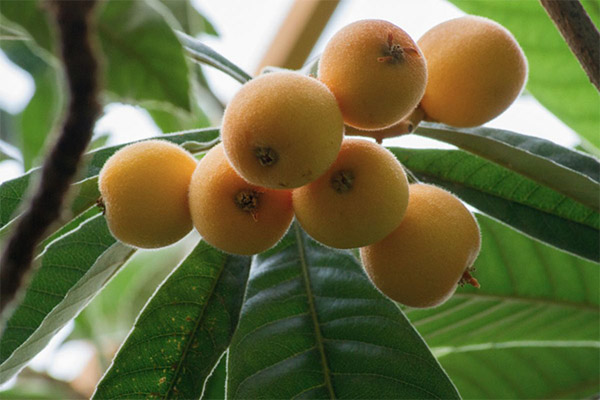
- The leaves of the medlar plant have anti-inflammatory and analgesic properties and can alleviate the symptoms of cancer.
- Extracts of the plant protect the body from cellular aging. In addition, they have a beneficial effect on the body during the course of HIV.
- Leaves can also be used to support brain function, protect against oxidative stress, improve cognitive abilities and memory.
- The leaves have anti-diabetic properties and are also widely used in the manufacture of remedies to help treat colds.
Health and beauty applications
Cherry plum is rich in vitamin A, antioxidants and astringents that are beneficial to the skin. Products based on it nourish and moisturize the skin and help delay aging. In addition, preparations based on the leaves of medlar can get rid of redness, irritation and other effects of the environment on sensitive skin. The pulp of the fruit can be added independently to any home masks, mixing with kefir, eggs, cosmetic clay.
Cherry plum in cooking
As a rule, the fruit of the medlar is used for eating, while the leaves and bark are used to prepare medicinal infusions and teas. The fruit is usually eaten fresh, often as part of various salads. The fruit can be used for making a variety of delicacies, such as marmalade, jam, jams, marshmallows and compotes, or as a candy filling. Cherry plums are also used in the process of making soft drinks and even wines.
Fruit medicated with medicated medications
The fruits of the evergreen plant have a number of useful properties, which have been known since ancient times. In the field of folk medicine, there are many recipes based on medications. For example, unripe fruits can be used to make decoctions for the treatment of diseases of the urinary system. Decoctions based on the fruit are used in cases of inflammations of the gastrointestinal tract and bloody diarrhea. Alcoholic tinctures are made from the pulp, which helps with bronchial asthma. The fruit is also useful for diseases of the blood vessels and heart. They can also help remove kidney stones and improve the condition in colic.
Harms and contraindications
Mushrooms are contraindicated in the following cases:
- Individual intolerance. If allergic reactions occur, it is necessary to refuse to eat the fruit and take antihistamines.
- Stomach problems. Before consuming medlars, it is necessary to consult a doctor.
How to choose and store medlars
When buying medlars, choose a slightly "rotten" fruit. You can tell the optimal level of maturity by touching it. In terms of size, medium-sized fruits are welcome, since small ones are usually too sour, and large ones are usually not very tasty.
When growing medlars on the plot, it is not recommended to remove the fruit from the trees immediately after ripening. But you should also consider that they are afraid of frost.
In the refrigerator, the medlar is stored no more than 2 days. It is recommended to lay the fruit in a single layer on dry sand or paper. You can pre-bath the fruit in a concentrated salt solution - this will prevent rot and mold.
How to eat medlars?
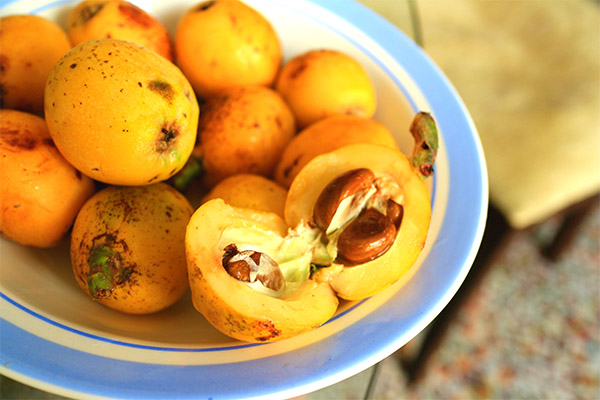
The medlars are best eaten in their natural state, since they contain the vitamins necessary for the body, which are lost after processing. The peel from the ripe fruit is fairly easy to separate, but if you have a desire, you can eat the fruit together with it. Peeled pulp can be combined with other ingredients in a shredded form in a variety of salads. The medlars are sometimes eaten stewed with added sugar. The pulp is great for gelatinous desserts, sauces, and for filling in baked goods.
Can I Eat the Pips
The kernels of medlars in their natural form are dangerous to health, because they contain poisonous hydrocyanic acid. It's not just not recommended to eat them, but strictly forbidden.
What can be made from medlars: recipes
Jam
Ingredients:
- medlars - 5 kg;
- sugar - 1,5 g;
- water - 1,5 l.
- lemon - 1 pc.
How to prepare:
- Cut the skin from the washed fruits and remove the pips.
- Pour water into a pot, add sugar, lemon juice and put on the fire. While boiling, stir constantly. Bring it to the boil, sugar has to dissolve.
- Put the fruit of the medlars in the pot. Cook for about 15 minutes on medium heat. Then take it off heat and leave it for 7-8 hours.
- Bring to the boil again, simmer for 5 minutes and let cool completely again.
- Carry out the boiling procedure 3 times (this is the total number of boils).
- Pour the jam in sterilized jars and seal.
Compote
Ingredients:
- fruits of medlars - 950 g;
- granulated sugar - 560 gr;
- Citric acid - 1 pinch.
- water - 1 l.
How to prepare:
- Cut the fruit into halves and remove the bone.
- Put the pulp in a saucepan (covered with enamel), add sugar and water. Place on fire.
- After boiling, simmer for about 7 minutes more.
- Add citric acid, pour the drink into sterile jars and seal them immediately.
Can I give animals medlars fruit
It is not recommended to give dogs this fruit. However, in some cases, pets are prescribed fluids based on medley, which alleviate colds and help get rid of coughs. It is better not to include this product in the cat's diet.
Interesting facts about the medlar fruit
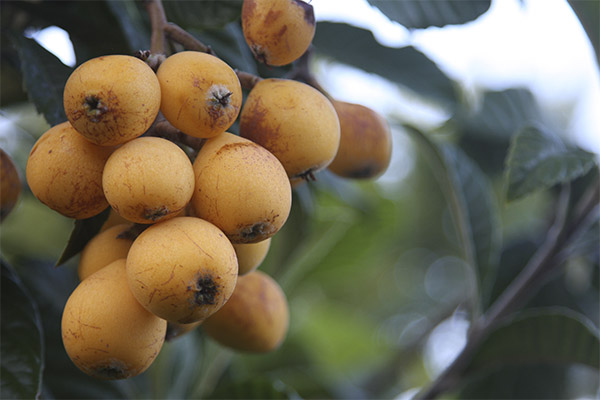
- In the wild, the medlar can live up to 50 years.
- The medlar stands out among fruit crops in that it blooms from fall to winter.
- It is native to China.
- The medlar has been cultivated in Japan for over 1,000 years.
- The fruit is used to make plum wine.
- It is believed that Chinese immigrants brought the medlar to Hawaii.
- The medlar is often mentioned in ancient Chinese literature (in the poems of Li Bai).
- In Japan, the leaves of the medlar are dried to make a drink known as "biwa cha" by boiling in the traditional Japanese method. According to some Japanese, biwa cha has beneficial effects on the appearance of skin and treats skin inflammation.
«Important: All information on this site is provided for informational purposes only purposes only. Before applying any recommendations, please consult with a specialist. specialist. Neither the editors nor the authors are liable for any possible harm caused by materials."

